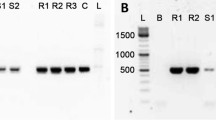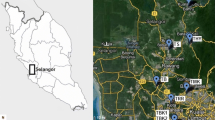Abstract
The presence of toxic cyanobacteria in aquaculture systems is a matter of concern due to its capability to produce toxin known as microcystin. This study was carried out to determine the presence, abundance and toxic potential of cyanobacteria in selected aquaculture systems in Perak, Malaysia, as well as to identify the potential main trigger of toxic cyanobacterial blooms in aquaculture water. In this study, a total of 40 freshwater fish ponds were sampled from 10 different aquaculture farms in Perak, Malaysia. Results revealed that the most frequently found cyanobacterial taxa in Perak aquaculture water was Microcystis spp., where it was detected in all of the studied ponds. During the sampling period, 75 % of the sampled ponds water contained unsafe levels of microcystin with concentrations up to 295.86 µg MC-LR equivalent L−1. This study also discovered that a combination of temperature and pH was the key environmental factor that triggered the proliferation and toxicity of cyanobacteria, whereby temperature was statistically proven to be a more powerful predictor in comparison with pH. This study has implied that cyanobacteria can present health risk to human through aquaculture fish consumption. Moreover, the risk posed by cyanobacteria in aquaculture systems will be amplified by the influence of global warming, with rising water temperatures up to 32 °C.



Similar content being viewed by others
References
American Public Health Association (APHA) (1998) Standard methods for the examination of water and wastewater, 20th edn. American Public Health Association, American Water Works Association, and Water Pollution Control Federation, Washington
Backer LC, Carmichael W, Kirkpatrick B, Williams C, Irvin M, Zhou Y, Johnson TB, Nierenberg K, Hill VR, Kieszak SM, Cheng YS (2008) Recreational exposure to low concentrations of microcystins during an algal bloom in a small lake. Mar Drugs 6(2):389–406
Bartram J (ed) (2015) Routledge handbook of water and health. Routledge, New York
Bellinger EG, Sigee DC (2010) Freshwater algae: identification and use as bioindicators. Wiley, Chichester
Butterwick C, Heaney SI, Talling JF (2005) Diversity in the influence of temperature on the growth rates of freshwater algae, and its ecological relevance. Freshw Biol 50(2):291–300
Chorus I, Bartram J (eds) (1999) Toxic cyanobacteria in water: a guide to their public health consequences, monitoring and management. World Health Organisation, London and New York
Davis TW, Harke MJ, Marcoval MA, Goleski J, Orano-Dawson C, Berry DL, Gobler CJ (2010) Effects of nitrogenous compounds and phosphorus on the growth of toxic and non-toxic strains of Microcystis during cyanobacterial blooms. Aquat Microb Ecol 61:149–162
Dokulil MT, Teubner K (2000) Cyanobacterial dominance in lakes. Hydrobiologia 438:1–12
Ferrão-Filho ADS, Kozlowsky-Suzuki B (2011) Cyanotoxins: bioaccumulation and effects on aquatic animals. Mar Drugs 9:2729–2772
Håkanson L, Bryhn AC, Hytteborn JK (2007) On the issue of limiting nutrient and predictions of cyanobacteria in aquatic systems. Sci Total Environ 379(1):89–108
Hudnell HK (ed) (2008) Cyanobacterial harmful algal blooms: state of the science and research needs. Springer Science and Business Media, New York
Intergovernmental Panel on Climate Change (IPCC) (2013) Climate change 2013: the physical science basis. Contribution of Working Group I to the Fifth Assessment Report of the Intergovernmental Panel on Climate Change. Cambridge University Press, Cambridge, United Kingdom, and New York
Jackson PE (2000) Ion chromatography in environmental analysis. In: Meyers RA (ed) Encyclopedia of Analytical Chemistry. Wiley, Chichester
Jewel MAS, Affan MA, Khan S (2003) Fish mortality due to cyanobacterial bloom in an aquaculture pond in Bangladesh. Pak J Biol Sci 6(12):1046–1050
Komarek J, Hauer T (2013) CyanoDB.cz—On-line database of cyanobacterial genera—World-wide electronic publication. University of South Bohemia and Institute of Botany AS CR. http://www.cyanodb.cz
Lawton LA, Edwards C, Codd GA (1994) Extraction and high-performance liquid chromatographic method for the determination of microcystins in raw and treated waters. Analyst 119:1525–1530
Lorenzen CJ (1967) Determination of chlorophyll and pheo-pigments: spectrophotometric equations. Limnol Oceanogr 12(2):343–346
Malaysian Meteorological Department (2015) Monthly weather bulletin. Malaysian Meteorological Department Website. http://www.met.gov.my/index.php?option=com_content&task=view&id=8 43&Itemid=1586
Meriluoto JAO, Codd GA (eds) (2005) Cyanobacterial monitoring and cyanotoxin analysis. ÅBO Akademi University Press, Finland
Mioni C, Kudela R, Baxa D, Sullivan M, Hayashi K, Smythe T, White C (2011) Harmful cyanobacteria blooms and their toxins in Clear Lake and the Sacramento-San Joaquin Delta (California). Central Valley Regional Water Quality Control Board, California
Mohd. Nasarudin H, Ruhana H (2007) Preliminary study on cyanobacteria composition and selected water quality parameters from freshwater fish (Tor tambroides) ponds in Serian, Sarawak. In: Proceedings of Natural Resources and Environmental Management (NREM) & ESH 2007. Kuching, Sarawak
Okogwu OI, Ugwumba AO (2009) Cyanobacteria abundance and its relationship to water quality in the Mid-Cross River floodplain, Nigeria. Revista de Biología Tropical 57(1/2):33–43
Otten TG, Xu H, Qin B, Zhu G, Paerl HW (2012) Spatiotemporal patterns and ecophysiology of toxigenic microcystis blooms in Lake Taihu, China: implications for water quality management. Environ Sci Technol 46:3480–3488
Paerl HW, Huisman J (2008) Climate. Blooms like it hot. Science 320(5872):57–58
Paerl HW, Huisman J (2009) Climate change: a catalyst for global expansion of harmful cyanobacterial blooms. Environ Microbiol Rep 1(1):27–37
Paerl HW, Otten TG (2013) Harmful cyanobacterial blooms: causes, consequences, and controls. Microb Ecol 65(4):995–1010
Paerl HW, Paul VJ (2012) Climate change: links to global expansion of harmful cyanobacteria. Water Res 46(5):1349–1363
Paerl HW, Tucker CS (1995) Ecology of blue-green algae in aquaculture ponds. J World Aquac Soc 26(2):109–131
Peng L, Liu Y, Chen W, Liu L, Kent M, Song L (2010) Health risks associated with consumption of microcystin-contaminated fish and shellfish in three Chinese lakes: significance for freshwater aquacultures. Ecotoxicol Environ Saf 73(7):1804–1811
Poste AE, Hecky RE, Guildford SJ (2011) Evaluating microcystin exposure risk through fish consumption. Environ Sci Technol 45:5806–5811
Qin B, Zhu G, Gao G, Zhang Y, Li W, Paerl HW, Carmichael WW (2010) A drinking water crisis in Lake Taihu, China: linkage to climatic variability and lake management. Environ Manage 45(1):105–112
Rita DP, Valeria V, Silvia BM, Pasquale G, Milena B (2014) Microcystin contamination in Sea mussel farms from the Italian Southern Adriatic coast following cyanobacterial blooms in an artificial reservoir. J Ecosyst 2014:1–11
Schmidt JR, Shaskus M, Estenik JF, Oesch C, Khidekel R, Boyer GL (2013) Variations in the microcystin content of different fish species collected from a eutrophic lake. Toxins 5:992–1009
Sinang SC, Reichwaldt ES, Ghadouani A (2013) Spatial and temporal variability in the relationship between cyanobacterial biomass and microcystins. Environ Monit Assess 25(4):367–380
Sinang SC, Keong BP, Shamsudin S, Sinden A (2015a) Preliminary assessment of cyanobacteria diversity and toxic potential in ten freshwater lakes in Selangor, Malaysia. Bulletin Environ Contam Toxicol 95(4):542–547
Sinang SC, Reichwaldt ES, Ghadouani A (2015b) Local nutrient regimes determine site-specific environmental triggers of cyanobacterial and microcystin variability in urban lakes. Hydrol Earth Syst Sci 19(5):2179–2195
Sinden A, Sinang SC (2015) Presence and abundance of cyanobacteria in selected aquaculture ponds in Perak, Malaysia and the relationships with selected physicochemical parameters of water. Jurnal Teknologi 76(1):1–6
Sivonen K, Jones G (1999) Cyanobacterial toxins. In: Chorus I, Bartram J (eds) Toxic cyanobacteria in water: a guide to their public health consequences, monitoring and management. World Health Organisation, London and New York
Smith K, Webster L, Bresnan E, Fraser S, Hay S, Moffat C (2007) A review of analytical methodology used to determine phytoplankton pigments in the marine environment and the development of an analytical method to determine uncorrected chlorophyll-a, corrected chlorophyll-a and phaeophytin-a in marine phytoplankton. Fisheries Research Services Internal Report No. 03/07, Aberdeen
Stone D, Bress W (2007) Addressing public health risks for cyanobacteria in recreational freshwaters: the Oregon and Vermont framework. Integr Environ Assess Manag 3(1):137–143
Su X, Xue Q, Steinman A, Zhao Y, Xie L (2015) Spatiotemporal dynamics of microcystin variants and relationships with environmental parameters in Lake Taihu, China. Toxins 7(8):3224–3244
Suneerat R, Wichien Y, Paveena T, Monthon G (2014) Cyanobacterial composition and microcystin accumulation in catfish pond. Chiang Mai J Sci 41(1):27–38
Vasconcelos JF, Barbosa JEL, Lira W, Azevedo SMFO (2013) Microcystin bioaccumulation can cause potential mutagenic effects in farm fish. Egyptian J Aquatic Res 39:185–192
Zhong F, Gao Y, Yu T, Zhang Y, Xu D, Xiao E, He F, Zhou Q, Wu Z (2011) The management of undesirable cyanobacteria blooms in Channel catfish ponds using a constructed wetland: contribution to the control of off-flavor occurrences. Water Res 45(19):6479–6488
Zimba PV, Khoo L, Gaunt PS, Brittain S, Carmichael WW (2001) Confirmation of catfish, Ictalurus punctatus (Rafinesque), mortality from Microcystis toxins. J Fish Dis 24(1):41–47
Acknowledgments
This research was funded by the Ministry of Education Malaysia under the research grant (2013-0002-101-72) provided. Authors would like to thank officers in charged in the Department of Fisheries (Batang Padang), Aquaculture Development Centre Tapah, and participating aquaculture companies in Perak State of Malaysia for their assistance and cooperation. During the study, Ann Sinden was supported by a scholarship from the State Government of Sarawak under Tunku Abdul Rahman Sarawak Scholarship Foundation (YBSTAR).
Author information
Authors and Affiliations
Corresponding author
Additional information
Editorial responsibility: M. Abbaspour.
Rights and permissions
About this article
Cite this article
Sinden, A., Sinang, S.C. Cyanobacteria in aquaculture systems: linking the occurrence, abundance and toxicity with rising temperatures. Int. J. Environ. Sci. Technol. 13, 2855–2862 (2016). https://doi.org/10.1007/s13762-016-1112-2
Received:
Revised:
Accepted:
Published:
Issue Date:
DOI: https://doi.org/10.1007/s13762-016-1112-2




